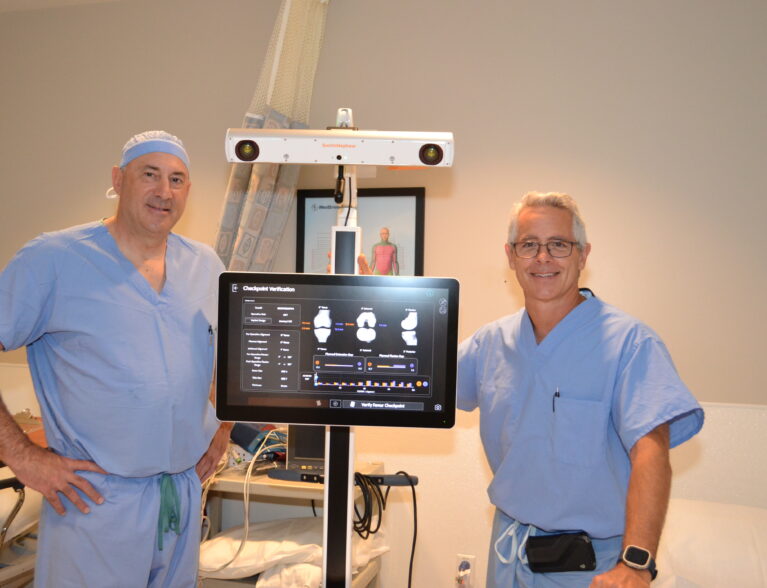
Two Vero Beach doctors are excited about the capabilities of the CORI Surgical System, which uses handheld robotics-assisted technology powered by Real Intelligence to help surgeons plan and perform knee-replacement surgeries.
It allows each patient to undergo a knee replacement that is shape-matched and aligned to their anatomy.
“Basically, we create a plan while the patient’s leg is exposed,” said Vero Beach orthopedic surgeon Dr. Ron Robinson. “We insert some antennas, one on the femur, one on the tibia, so that the computer knows exactly where the femur and tibia are at all times. Then we take an instrument that is essentially a stylus that has another antenna on it, and we paint the entire knee.
“We cover all of the anatomy so that now the computer knows exactly where all parts of the knee are as you range the knee, and we are measuring through full range of motion how much gap there is between the pieces,” Dr. Robinson continued.
“We want to perfect that, so we’re able to virtually put in all the components in the knee and balance it before we’ve ever made a cut. We finalize the plan and then use the high-speed burr to create bone cuts exactly where we want them.”
The process is spelled out succinctly in the CORI Surgical System Global Messaging Guide:
“At the beginning of the surgery, your surgeon uses the CORI surgical system to create a customized 3D digital model of your knee. This three-dimensional view helps the surgeon finalize and verify the right size implant for you and creates a detailed surgical plan for how your replacement will be placed to optimize movement and function.
“During the procedure, the CORI Surgical System works in conjunction with your surgeon’s skilled hand to achieve accurate positioning of the knee implant based on the patient’s own anatomy. The system sends precise information about your knee to the robotics assisted handpiece more than 300 times per second, allowing your surgeon to remove damaged surfaces, balance your joint and position the implant with accuracy.
“The CORI Surgical System also helps your surgeon perform the procedure as planned, giving you the benefits of the accuracy of robotics assistance and the skill and training of your experienced surgeon. The result is a naturally shaped knee that is positioned with an added level of accuracy to allow for a faster, smoother recovery.”
“We have a range of components for the femur, another series of components for the tibia, and then the plastic that meshes the two together,” Dr. Robinson said.
“We work in various sizes and mix different sizes on the femur versus tibia. The robot is positioning it so that it is accurately placed. The biggest problem with joints is what we call gap balancing. When your knee is straight, there is a certain amount of space between the femur and the tibia, and through full range of motion that space needs to be accounted for.
We make the components to match the amount of space to fill the gap so that you have equal balance in the extension and inflection. The robotic method gives us accurate numbers through full range of motion, so it’s much more precise in balancing the knee.”
For patients concerned about exposure to radiation, the CORI Surgical System’s real-time planning eliminates the requirement to undergo a preoperative CT scan.
“We do everything as part of your surgery right then and there,” said orthopedic surgeon Dr. Richard Steinfeld. “It allows us to collect data, map the surfaces in the knee which gives us sizes, and it also gives us a contour of the knee. It’s a powerful platform.
“What’s very important in knee replacement surgery is when you bend and straighten your knee, there should be the same amount of space between those bones,” Dr. Steinfeld continued. “That’s what keeps your ligament size and tension and what makes your knee stable. With all the data that we feed to the robot, we can take that information and manipulate where we would put the implants, so those spaces are perfect.
“We do all of that before we even touch the bone. It’s basically like running through the operation without touching the patient’s bone yet. The feedback from the robot tells us when those gaps are balanced. We lock it in and then we can make cuts with a high-speed burr.
The computerized system won’t allow us to cut any bone or tissue that we aren’t supposed to so it’s like a built-in safety stop. Previously we had to do it all manually by sight and feel.”
When it comes to knee surgery, accuracy is important because if an implant is positioned incorrectly, it may not function properly. You’ll also regain function faster after CORI-assisted surgery, according to the two surgeons. Most knee replacements are performed as outpatient surgeries, with patients sent home the same day.
Dr. Ron Robinson and Dr. Richard Steinfeld are part owners of Grove Place Surgery Center, Vero Beach. Dr. Robinson can be reached at Vero Elite Rehab and Orthopaedic Surgery and Pro Sports, 772-978-7808. Dr. Steinfeld can be reached at Orthopaedic Center of Vero Beach, 772-778-2009, extension 1113.



